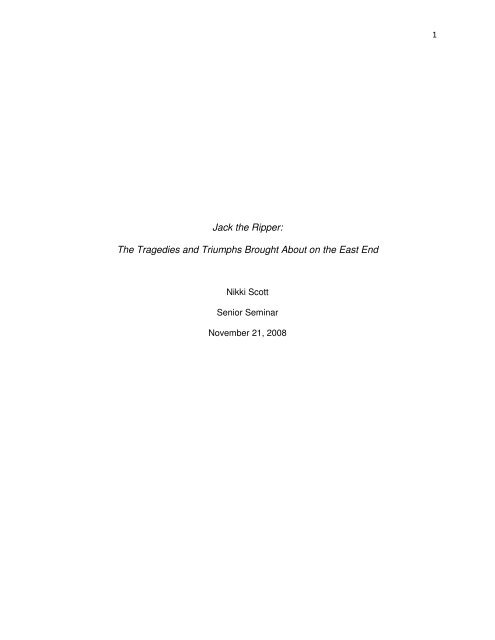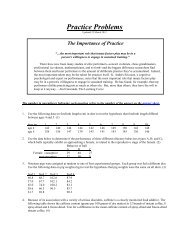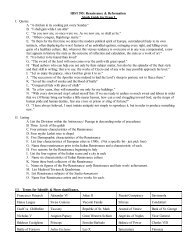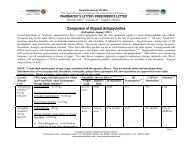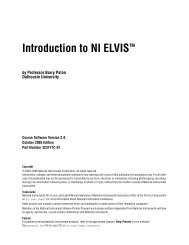Jack the Ripper - Harding University
Jack the Ripper - Harding University
Jack the Ripper - Harding University
You also want an ePaper? Increase the reach of your titles
YUMPU automatically turns print PDFs into web optimized ePapers that Google loves.
1<br />
<strong>Jack</strong> <strong>the</strong> <strong>Ripper</strong>:<br />
The Tragedies and Triumphs Brought About on <strong>the</strong> East End<br />
Nikki Scott<br />
Senior Seminar<br />
November 21, 2008
2<br />
“Eyes open, hands by her side, skirt hiked up to her waist and legs slightly<br />
apart.” 1<br />
This was only <strong>the</strong> beginning to <strong>the</strong> terrifying legend that would be known<br />
around <strong>the</strong> world as <strong>Jack</strong> <strong>the</strong> <strong>Ripper</strong>. <strong>Jack</strong> <strong>the</strong> <strong>Ripper</strong> is infamous for his/her killings of<br />
prostitutes, and not just simple murders, but horrifying, life changing events.<br />
Themystery of who <strong>Jack</strong> <strong>the</strong> <strong>Ripper</strong> will always be unknown, but <strong>the</strong> things we do know<br />
are how <strong>the</strong>se murders changed London society. To show how <strong>the</strong>se changes came<br />
about, background knowledge of <strong>the</strong> murders has to be presented.<br />
Before <strong>the</strong> murders that would change <strong>the</strong> world happened, London was split into<br />
two. London was made up of two sections, <strong>the</strong> East End and <strong>the</strong> West End. Their<br />
personalities and inhabitants were entirely different and chose for <strong>the</strong> most part to stay<br />
that way by having almost no interaction. The West End contained <strong>the</strong> wealthy, higher<br />
class. Their children were raised by nannies, houses contained fine silver, and balls<br />
were a part of everyday life. The East End held beggars, thieves, rats, homeless<br />
children, and prostitutes. William Fisherman puts it best when he states, “The East End<br />
was a complex tapestry of peoples and institutions where dire poverty was occasionally<br />
relieved by spacious middle class enclaves.” 2 The two ends knew <strong>the</strong>y had nothing in<br />
common and felt as though <strong>the</strong>y had nothing to offer, or just didn’t want to offer<br />
anything. On October 2, 1888 <strong>the</strong> Daily Telegraph reported that, “The majority of <strong>the</strong><br />
inhabitants of West and Central London know as much [about <strong>the</strong> East End] as <strong>the</strong>y do<br />
<strong>the</strong> Hindu Kush or <strong>the</strong> Nor<strong>the</strong>rn Territory of Sou<strong>the</strong>rn Australia.” 3<br />
This however, would<br />
all soon change for <strong>the</strong> people of London, England.<br />
1 John Douglas, The Cases that Haunt Us: From <strong>Jack</strong> <strong>the</strong> <strong>Ripper</strong> to JonBenet (New York: A Lisa Drew Book, 2000),<br />
24.<br />
2 L. Perry Curtis Jr., <strong>Jack</strong> <strong>the</strong> <strong>Ripper</strong> and <strong>the</strong> London Press (New Haven and London: Yale <strong>University</strong>, 2001), 33-34.<br />
3 Ibid., 35
3<br />
There have been thousands of people who have tried to solve <strong>the</strong> mystery<br />
behind <strong>Jack</strong> <strong>the</strong> <strong>Ripper</strong> and along <strong>the</strong> way <strong>the</strong>re have been agreements and<br />
disagreements. The main issues are who were actually <strong>the</strong> victims, and of course who<br />
did it. There are however several women that most all historians and “<strong>Ripper</strong>ologist”<br />
agree on, those are: Emma Turner, Mary Ann Nichols, or known to her friends as Polly,<br />
Annie Chapman, Elizabeth Stride, Ca<strong>the</strong>rine Eddowes and Mary Jane Kelly. 4<br />
August 6, 1888, Emma Turner is found dead. She is examined by medical<br />
doctor, Dr. Timothy Killeen, where he discovers thirty-nine stab wounds in <strong>the</strong> breast,<br />
abdominal and genital area. 5 Was this just ano<strong>the</strong>r murder? Though she is considered<br />
by many to be <strong>the</strong> first victim of <strong>Jack</strong> <strong>the</strong> <strong>Ripper</strong>, <strong>the</strong>re are still many speculators who<br />
say <strong>the</strong> first murder really began with Mary Ann “Polly” Nichols. Of <strong>the</strong> women, Miss<br />
Turner is <strong>the</strong> one that many historians have a hard time accepting.<br />
Friday, August 31, 1888, <strong>the</strong>re are two men driving a wagon along Bucks Row<br />
who come across and object in <strong>the</strong> road. One man jumps down to remove <strong>the</strong> object<br />
out of <strong>the</strong> horse’s way and finds it to be <strong>the</strong> body of a forty-five year old prostitute, Mary<br />
Ann “Polly” Nichols. 6 The woman’s face was still warm when <strong>the</strong> men found her,<br />
meaning she wasn’t killed too long before <strong>the</strong>ir arrival. 7<br />
Dr. Russ Ralph Llewllyn was<br />
<strong>the</strong> examiner on <strong>the</strong> scene and notes several lacerations on <strong>the</strong> victims throat, but very<br />
little blood. 8<br />
Upon later examination it was discovered that her stomach had been<br />
4 John Douglas, The Cases that Haunt Us: From <strong>Jack</strong> <strong>the</strong> <strong>Ripper</strong> to JonBenet (New York: A Lisa Drew Book, 2000),<br />
23-39.<br />
5 Ibid., 28<br />
6 Ibid., 23-24<br />
7 Ibid., 24<br />
8 Ibid., 24
4<br />
ripped open and her intestines were exposed. 9<br />
Because of <strong>the</strong> mutilation done to her<br />
body, Dr. Llewellyn believed that <strong>the</strong> murderer might have some anatomical knowledge<br />
and could possibly be left handed due to bruisers on Mary Ann Nichols neck. 10<br />
This is<br />
how <strong>the</strong> idea that <strong>the</strong> murder could have been a surgeon was brought about.<br />
Annie Chapman was thought to be <strong>the</strong> next victim of <strong>Jack</strong> <strong>the</strong> <strong>Ripper</strong>. Saturday,<br />
September 8, 1888 Miss Chapman was found in a back alley with her face down and<br />
her dress over her head. 11<br />
Her intestines were pulled out and hung over her left<br />
shoulder, and her throat was “disserved deeply”. 12 With deeper examination it was<br />
found that her genitals had been cut out. 13<br />
Inspector Joseph Chandler was <strong>the</strong> first to<br />
arrive on <strong>the</strong> scene and shortly followed by Inspector Frederick George Abberline; <strong>the</strong><br />
two men inspected <strong>the</strong> area and found a lea<strong>the</strong>r apron near <strong>the</strong> victim’s body. 14<br />
The <strong>the</strong>ory behind this murder became known as “Lea<strong>the</strong>r Apron”. With<br />
newspapers talking about <strong>the</strong> idea that <strong>the</strong> murderer could possibly be from foreign<br />
lands people began to believe that <strong>the</strong> murderer could possibly be Jewish. 15<br />
The public<br />
turned towards a Jewish man by <strong>the</strong> name of John Pizer. 16<br />
Mr. Pizer had been seen<br />
around Whitechapel shaking prostitutes and demanding money; a bully to <strong>the</strong> ladies of<br />
<strong>the</strong> streets. 17<br />
He was also seen threatening a woman at knifepoint and known for<br />
9 John Douglas, The Cases that Haunt Us: From <strong>Jack</strong> <strong>the</strong> <strong>Ripper</strong> to JonBenet (New York: A Lisa Drew Book, 2000),<br />
25.<br />
10 Ibid., 25<br />
11 Ibid., 29<br />
12 Ibid., 29<br />
13 Ibid., 30<br />
14 Ibid., 29-30<br />
15 Ibid., 34<br />
16 Ibid., 35<br />
17 Ibid., 34
5<br />
starting fights. 18<br />
He was arrested on September 10, but released a day and a half later<br />
when his alibi was found to be true. 19<br />
The next <strong>Ripper</strong> attack was on forty-four year old Elizabeth Stride, on Sunday<br />
September 30, 1888. She is believed to have been killed standing up, and unlike <strong>the</strong><br />
scene at Mary Ann Nichols murder site, <strong>the</strong>re was much blood, and it seemed that she<br />
might have been <strong>the</strong> only victim to fight back. 20<br />
Two doctors and a police surgeon<br />
arrived at <strong>the</strong> scene and began an examination. It appeared that her throat had been<br />
slashed, dress pulled over her waist, abdomen split open, intestines out and hung over<br />
<strong>the</strong> right shoulder, uterus and kidneys removed and never found, and her face and right<br />
ear were mutilated. 21<br />
The same night of Stride’s death, Ca<strong>the</strong>rine Eddowes was also discovered<br />
dead. 22<br />
Miss Eddowes was found lying on her back with her left leg extended and right<br />
leg slightly bent. 23<br />
Her right cheek had been slashed which also took off <strong>the</strong> tip of her<br />
nose and a portion of ear. 24 When <strong>the</strong> victim was discovered as Ca<strong>the</strong>rine Eddowes <strong>the</strong><br />
police found it odd for <strong>the</strong> fact Miss Eddowes was in police custody shortly before her<br />
death, due to her being passed out on <strong>the</strong> pavement in Aldgate. 25<br />
The cases of<br />
Elizabeth Stride and Ca<strong>the</strong>rine Eddowes become known as <strong>the</strong> “double event.”<br />
Friday, November 9, Lord Mayor’s Day, <strong>the</strong> worst of <strong>the</strong> killings took place and<br />
for <strong>the</strong> first time it took place inside. Mary Jane Kelly was renting a room in Miller’s<br />
18 Ibid., 35<br />
19 John Douglas, The Cases that Haunt Us: From <strong>Jack</strong> <strong>the</strong> <strong>Ripper</strong> to JonBenet (New York: A Lisa Drew Book, 2000),<br />
35.<br />
20 Ibid., 35<br />
21 Ibid., 39<br />
22 Judith R. Walkowitz, “<strong>Jack</strong> <strong>the</strong> <strong>Ripper</strong> and <strong>the</strong> Myth of Male Violence,” Feminist Studies 8, no. 3 (1982): pg. 193,<br />
http://www.jstor.org/stable/3177712<br />
23 Donald Rumbelow, <strong>Jack</strong> <strong>the</strong> <strong>Ripper</strong>: The Complete Casebook (New York: Berkley Book, 1990), 66.<br />
24 Ibid., 66<br />
25 Ibid., 67
6<br />
Court that had a cheap bed, small table and a chair on which her clo<strong>the</strong>s were lying. 26<br />
The horror that took place even made newspaper editors worry about putting details in<br />
<strong>the</strong>ir papers. 27<br />
Though it took police surgeons hours to figure out if Mary’s body parts<br />
were missing or just spread throughout <strong>the</strong> room <strong>the</strong>y reported that her ears and nose<br />
were cut off, her face was so slashed up that she was unrecognizable, her stomach and<br />
abdomen were torn apart, breast, heart and kidneys were removed and placed on a<br />
table, her genitals were mangled toge<strong>the</strong>r and her liver was removed and placed on her<br />
right thigh. 28<br />
Through medical examination of all <strong>the</strong> bodies, so things were found and should<br />
be dooly noted. Such things as: “no evidence of sexual assault, subject killed victims<br />
swiftly, subject was able to maintain control of victims during <strong>the</strong> initial blitz-style attack,<br />
subject removed body organs from some of <strong>the</strong> victims, indicating some anatomical<br />
knowledge or curiosity, no evidence of physical torture prior to death, severe<br />
postmortem mutilation, evidence of manual strangulation, in most cases blood was<br />
concentrated in most areas, rings were taken from one of <strong>the</strong> victims, <strong>the</strong> last victim was<br />
killed indoors and was <strong>the</strong> most mutilated, time of death in all cases was in <strong>the</strong> earlymorning<br />
hours.” 29<br />
Public reaction and concern grew with every murder and <strong>the</strong> death of Mary Kelly<br />
escalated tensions even more. In Joseph Fisher’s book, Killer among Us: Public<br />
Reaction to Serial Murder, he explains that people use “rational explanation,<br />
26 L. Perry Curtis Jr., <strong>Jack</strong> <strong>the</strong> <strong>Ripper</strong> and <strong>the</strong> London Press (New Haven and London: Yale <strong>University</strong>, 2001), 186.<br />
27 Ibid., 186<br />
28 Joseph C. Fisher, Killer Among Us: Public Reaction to Serial Murder (Westport: Greenwood Publishing Group,<br />
1997), 202.<br />
29 John Douglas, The Cases that Haunt Us: From <strong>Jack</strong> <strong>the</strong> <strong>Ripper</strong> to JonBenet (New York: A Lisa Drew Book, 2000),<br />
62.
7<br />
supernatural appeals, and transference,” to make sense of what’s going on around<br />
<strong>the</strong>m and to calm <strong>the</strong>mselves. 30 Writer George Bernard Shaw,explained <strong>the</strong> situation as,<br />
“Whilst we conventional social Democrats were wasting our time on education,<br />
agitation, and organization, some independent genius has taken matters into his own<br />
hand.” 31<br />
By saying this he draws attention to <strong>the</strong> fact that <strong>the</strong> upper class has spent so<br />
much time ignoring <strong>the</strong> East End that it took a mad man to make <strong>the</strong>m see what was<br />
really going on <strong>the</strong>re. Though <strong>the</strong> murders took place between August and November,<br />
<strong>the</strong> public reaction made it seem as though <strong>the</strong>y were carried out over a year. The<br />
public was now controlled by fear and anxiety, andat this time <strong>the</strong>y were willing to help<br />
out police in any way possible. 32<br />
The people even came up with ideas to help catch <strong>the</strong><br />
murderer and stop <strong>the</strong> killings. A few things <strong>the</strong>y suggested were, “pardoning<br />
accomplices, making everyone in Whitechapel report before going to bed, dressing<br />
police as women, arming prostitutes with pistols, putting police in rubber shoes so <strong>the</strong>y<br />
could sneak up on <strong>the</strong> killer, allowing police to stop and search anyone for knives, using<br />
handwriting experts, and putting ‘baby-faced pugilist’ in women’s clothing so <strong>the</strong>y could<br />
pummel would-be attackers.” 33 Police increased patrol, performed house-to-house<br />
searches, questions “polyandrous women” and made dozens of arrest. 34<br />
Bloodhounds<br />
were brought in, rewards were offered and women carried whistles and walked in<br />
groups. 35<br />
Even a Vigilance Committee was established and had volunteers to patrol <strong>the</strong><br />
30 Joseph C. Fisher, Killer Among Us: Public Reaction to Serial Murder (Westport: Greenwood Publishing Group,<br />
1997), 199.<br />
31 Ibid., 200<br />
32 Ibid., 202<br />
33 Ibid., 202<br />
34 Ibid., 202<br />
35 Ibid., 202-203
8<br />
area. 36<br />
This group was started by George Akin Lusk; he restored music halls for a<br />
living, but <strong>the</strong>n ended up writing about <strong>Jack</strong> <strong>the</strong> <strong>Ripper</strong> in <strong>the</strong> Times. 37 The fear even<br />
reached <strong>the</strong> West End and 5,000 women petitioned Queen Victoria asking her to<br />
“suppress moral disorders” and close <strong>the</strong> “bad houses” in which “such wickedness is<br />
done and men and women are ruined in body and soul.” 38 The chaos of <strong>the</strong> murders<br />
spread quickly and people’s blood boiled with fear. It is said that, “On Tuesday<br />
afternoon Mrs. Burridge, a shopkeeper of <strong>the</strong> BlackfriarsRoad, was reading an account<br />
of <strong>the</strong> Whitechapel murder that she was so affected <strong>the</strong>reby that she fell down in a fit<br />
and died.” 39<br />
Some of <strong>the</strong> public gave <strong>the</strong> <strong>Ripper</strong> <strong>the</strong> name “Savage of Civilization”;<br />
while o<strong>the</strong>rs believed he was sent on a mission from God to rid <strong>the</strong> slums of<br />
prostitutes. 40<br />
It seemed as though <strong>the</strong> community might have been brought toge<strong>the</strong>r to capture<br />
<strong>the</strong> murderer, but this was far from <strong>the</strong> truth. Neighbors turned on one ano<strong>the</strong>r, different<br />
races began to blame <strong>the</strong> o<strong>the</strong>r and everyone was suspicious and untrusting. A<br />
newspaper article wrote, “It seemed at times if every person in <strong>the</strong> streets were<br />
suspicious of everyone else he met, and as if it were a race between <strong>the</strong>m who should<br />
first inform against his neighbor.” 41<br />
With fear and anxiety comes blame. There were everyday suspect that <strong>the</strong><br />
crowds you like to blame. Men dressed nicely who came down to Whitechapel to view<br />
36 Joseph C. Fisher, Killer Among Us: Public Reaction to Serial Murder (Westport: Greenwood Publishing Group,<br />
1997), 203.<br />
37 John Douglas, The Cases that Haunt Us: From <strong>Jack</strong> <strong>the</strong> <strong>Ripper</strong> to JonBenet (New York: A Lisa Drew Book, 2000),<br />
54.<br />
38 Joseph C. Fisher, Killer Among Us: Public Reaction to Serial Murder (Westport: Greenwood Publishing Group,<br />
1997), 203.<br />
39 Ibid., 203<br />
40 Ibid., 205<br />
41 Ibid., 211
9<br />
<strong>the</strong> scenes, and would be attacked by <strong>the</strong> mob. Neighbors turned on neighbors and<br />
accusations flew everywhere. However, <strong>the</strong>re are some realistic thoughts of who could<br />
have been <strong>Jack</strong> <strong>the</strong> <strong>Ripper</strong>.<br />
George Chapman, a barber born in Poland, was found guilty for poisoning three<br />
of his wives and was hung in 1903. 42<br />
It was even heard that Inspector Abberline<br />
remarked, “You’ve got <strong>Jack</strong> <strong>the</strong> <strong>Ripper</strong> at last.” 43<br />
Ano<strong>the</strong>r suspect was Dr. Neill Cream;<br />
he was charged with poisoning four prostitutes, and was called “LambethPoisoner”. 44<br />
At his hanging in 1892 his last words were, “I am <strong>Jack</strong> <strong>the</strong>…” just <strong>the</strong>n <strong>the</strong> trapdoor<br />
pulled out from under his feet. 45<br />
The fact that this individual was a doctor credits him<br />
with knowing <strong>the</strong> human body. This could be noted as evidence against Dr. Cream, and<br />
certainly makes one think about <strong>the</strong> last words he ever spoke.<br />
Its interesting that <strong>the</strong> royal family and those that were involved with <strong>the</strong> royal<br />
family made for popular suspects. The royal family physician, Dr. William Gull was<br />
considered a reliable suspect for <strong>the</strong> face that he suffered a stroke, became homicidal<br />
and killed a woman to cover up a plot to dethrone Prince Albert. 46<br />
James K. Stephen,<br />
was ano<strong>the</strong>r person some looked to for possible motives to kill <strong>the</strong> prostitutes. He was<br />
<strong>the</strong> royal family was a tutor to Prince Albert. 47 He was known for harsh anti-female<br />
poetry and was thought to have a homosexual relationship with Prince Albert. 48<br />
He was<br />
diagnosed with syphilis and died in an asylum in 1892. 49<br />
42 Joseph C. Fisher, Killer Among Us: Public Reaction to Serial Murder (Westport: Greenwood Publishing Group,<br />
1997), 214.<br />
43 Ibid., 214<br />
44 Ibid., 214<br />
45 Ibid., 214<br />
46 Ibid., 214<br />
47 Ibid., 214<br />
48 Ibid., 214<br />
49 Ibid., 214
10<br />
The most popular and sought-after suspect of <strong>the</strong> <strong>Ripper</strong> cases was Prince<br />
Albert himself. Prince Albert was <strong>the</strong> Duke of Clarence and second inline to <strong>the</strong><br />
throne. 50<br />
He had a reputation of ignorance, mindlessness and was even considered<br />
mad. One of <strong>the</strong> main factors, however which shows strong evidence of why Prince<br />
Albert might not be <strong>Jack</strong> <strong>the</strong> <strong>Ripper</strong> is that he was reportedly out of London when one of<br />
<strong>the</strong> murders was committed. 51<br />
Some will still argue though that <strong>the</strong> fact that he was out<br />
of town doesn’t mean anything because he could have easily escaped arrest because<br />
of his rank in society.<br />
A man by <strong>the</strong> name, Montague J. Pruitt (or Druitt) 52 who happened to resemble<br />
Prince Albert, was ano<strong>the</strong>r possible suspect. 53<br />
There are two reasons Mr. Pruitt is<br />
suspected. One, he was Scotland CID Sir Melville Macnaghten’s number one<br />
suspect. 54<br />
Secondly, he committed suicide in November 1888, right around <strong>the</strong> time <strong>the</strong><br />
murders ended. 55<br />
He was considered sexually insane and even his family considered<br />
him to possibly be <strong>the</strong> <strong>Ripper</strong>. 56<br />
William Stewart is <strong>the</strong> first person to bring <strong>the</strong> thought that <strong>Jack</strong> <strong>the</strong> <strong>Ripper</strong> could<br />
possibly be Jill <strong>the</strong> <strong>Ripper</strong>. 57<br />
He believes that she was a midwife and possibly an<br />
abortionist. 58<br />
Stewart believes his mad midwife could have possibly been a scorned<br />
woman out for revenge of a woman who betrayed her. 59 He believes that a midwife is a<br />
50 Ibid., 214<br />
51 Ibid., 214<br />
52 Some sources claim that <strong>the</strong> gentleman’s last name is Druitt. Donald Rumbelow, 133.<br />
53 Joseph C. Fisher, Killer Among Us: Public Reaction to Serial Murder (Westport: Greenwood Publishing Group,<br />
1997), 214.<br />
54 Ibid., 214<br />
55 Ibid., 214<br />
56 Donald Rumbelow, <strong>Jack</strong> <strong>the</strong> <strong>Ripper</strong>: The Complete Casebook (New York: Berkley Book, 1990), 133.<br />
57 Case Book of <strong>Jack</strong> <strong>the</strong> <strong>Ripper</strong><br />
58 Ibid.<br />
59 Ibid.
11<br />
very possible killer for <strong>the</strong> fact that she could walk around town unnoticed, she has<br />
anatomical knowledge and that if her clo<strong>the</strong>s were bloodstained no one would think<br />
much about it. 60<br />
He made <strong>the</strong> claim that Mrs. Mary Pearcey was <strong>the</strong> midwife to be<br />
questiond. In October of 1890, Mrs. Pearcey had stabbed her lover’s wife and child to<br />
death and cut <strong>the</strong>ir throats and later wheeled <strong>the</strong>ir bodies into <strong>the</strong> street. 61<br />
Sir Melville<br />
Macnaghten wrote, “I have never seen a woman of stronger physique…her nerves were<br />
as iron cast as her body.” 62 Though this is a very interesting <strong>the</strong>ory, it is not very strong<br />
with evidence and discredited by many <strong>Ripper</strong>ologist.<br />
Letters from <strong>the</strong> <strong>Ripper</strong>, himself, increased paranoia in <strong>the</strong> city of London. Many<br />
letters were sent in that were found to be hoax, but <strong>the</strong>re are a few credited to <strong>the</strong> real<br />
<strong>Jack</strong> <strong>the</strong> <strong>Ripper</strong>. The “Dear Boss” letter and “Saucy <strong>Jack</strong>” postcard are considered to<br />
be au<strong>the</strong>ntic by most investigators and historians, but like most areas in this case not<br />
everyone agrees. The “Dear Boss” was first written on September 25, 1888, but post<br />
marked September 27. 63 In it <strong>the</strong> author criticizes and laughs at <strong>the</strong> police attempts to<br />
catch him and even admits to standing around <strong>the</strong> crime scenes to watch <strong>the</strong>m<br />
investigate. 64 He or she also mocks <strong>the</strong> idea of “Lea<strong>the</strong>r Apron”. 65 The author of <strong>the</strong><br />
letter also mentions how <strong>the</strong>y will cut off <strong>the</strong> ear of <strong>the</strong> next victim to send to <strong>the</strong> police<br />
and he or she wanted to write this letter in <strong>the</strong> blood of <strong>the</strong> victim but it dried up into a<br />
glue-like substance. 66 When signing <strong>the</strong> letter <strong>the</strong> author signs it “<strong>Jack</strong> <strong>the</strong> <strong>Ripper</strong>” and<br />
60 Ibid.,<br />
61 Ibid.<br />
62 Ibid.<br />
63 John Douglas, The Cases that Haunt Us: From <strong>Jack</strong> <strong>the</strong> <strong>Ripper</strong> to JonBenet (New York: A Lisa Drew Book, 2000),<br />
53.<br />
64 Whitechapel Society<br />
65 Ibid.<br />
66 Whitechapel Society
12<br />
politely states, “Don’t mind me giving <strong>the</strong> trade name.” 67 The “Saucy <strong>Jack</strong>” postcard is<br />
<strong>the</strong> next letter to look at, for it gains more support than many o<strong>the</strong>rs for actually being<br />
from <strong>Jack</strong> <strong>the</strong> <strong>Ripper</strong>. This letter is much shorter than <strong>the</strong> previous one, but still just as<br />
personal, as if <strong>the</strong> individual is writing to a friend. They mention <strong>the</strong> double murder and<br />
how <strong>the</strong>y couldn’t finish it and also that he or she is still working on getting <strong>the</strong> souvenir<br />
ear for <strong>the</strong> police. 68 There is yet ano<strong>the</strong>r letter and package that should be considered<br />
very seriously in this case. On October 16, 1888, George Akin Lusk, <strong>the</strong> man who<br />
started <strong>the</strong> Whitechapel Vigilance Committee, received a package with a London<br />
postmark. 69<br />
In <strong>the</strong> package was a kidney soaked in wine and wrapped around <strong>the</strong><br />
kidney was a letter. The letter read like this: 70<br />
From hell<br />
Mr Lusk<br />
Sor<br />
I send you half <strong>the</strong> Kidne I took from one woman prasarved if for you to<strong>the</strong>r<br />
piece I friend and ate it was very nise I may send you <strong>the</strong> bloody knife that took it out if<br />
you only wat a whil longer.<br />
Signed<br />
Catch me when you can<br />
Mishter Lusk. 71<br />
At first this letter was considered to be ano<strong>the</strong>r hoax, but Mr. Lusk still sent it to<br />
authorities. Upon examination <strong>the</strong> kidney was found to be from a human, about <strong>the</strong> age<br />
of forty-five and suffering from Bright’s disease. 72 Bright’s disease was commonly seen<br />
in alcoholics and it is believed that <strong>the</strong> prostitutes killed by <strong>Jack</strong> <strong>the</strong> <strong>Ripper</strong> all had<br />
67 Ibid.<br />
68 John Douglas, The Cases that Haunt Us: From <strong>Jack</strong> <strong>the</strong> <strong>Ripper</strong> to JonBenet (New York: A Lisa Drew Book, 2000),<br />
50.<br />
69 Ibid., 54<br />
70 The letter is written exactly how it was received from Mr. Lusk; <strong>the</strong> spelling and grammar are apart of <strong>the</strong> actual<br />
letter<br />
71 John Douglas, The Cases that Haunt Us: From <strong>Jack</strong> <strong>the</strong> <strong>Ripper</strong> to JonBenet (New York: A Lisa Drew Book, 2000),<br />
54.<br />
72 Douglas, 54
13<br />
drinking problems, beyond <strong>the</strong> extent of an occasional beer and rum. 73<br />
Some experts<br />
suggest that <strong>the</strong> language and spelling in <strong>the</strong> letters were more Irish than British. 74<br />
Whe<strong>the</strong>r <strong>the</strong> person who wrote <strong>the</strong> letters is of Irish decent or not cannot be determined,<br />
however it is factual to say that <strong>the</strong> author of <strong>the</strong> letters was not common with <strong>the</strong><br />
English language and writes how he or she would speak. 75 Were <strong>the</strong>se letters genuine<br />
and from <strong>the</strong> real <strong>Jack</strong> <strong>the</strong> <strong>Ripper</strong>? Did he or she want to get caught or just scare <strong>the</strong><br />
public more? These answers and so much more still haunt people all over <strong>the</strong> world<br />
today. <strong>Jack</strong> <strong>the</strong> <strong>Ripper</strong> still sits in <strong>the</strong> minds of criminologist, sociologist, detectives and<br />
historians.<br />
Many reporters from <strong>the</strong> Timesbegan to look more closely at <strong>the</strong> area in which<br />
<strong>the</strong>se murders have been taking place. One journalist of <strong>the</strong> Times remarks, “Can we<br />
doubt that neglected human refuse as inevitable breeds crime, that crime reproduces<br />
itself like germs in an infected atmosphere, and becomes at each successive cultivation<br />
more deadly, more bestial, and more absolutely unrestrained.” 76<br />
The East End was<br />
given <strong>the</strong> name “East End Murderland”. In ano<strong>the</strong>r article of <strong>the</strong> Times it is written,<br />
“Unhappily for all of us <strong>the</strong> Whitechapel murderers and <strong>the</strong>ir victims are neighbors of<br />
every Londoner.” 77 Allotting to <strong>the</strong> fact that <strong>the</strong> <strong>Jack</strong> <strong>the</strong> <strong>Ripper</strong> murders are not only<br />
affecting <strong>the</strong> East End, but everyone in London and that at some point <strong>the</strong> West End<br />
must acknowledge that <strong>the</strong> poor and <strong>the</strong> rich are neighbors. Now just because <strong>the</strong><br />
press is showing that <strong>the</strong> East End and West End are connected doesn’t mean that <strong>the</strong>y<br />
73 Douglas, 54<br />
74 Ibid., 55<br />
75 Ibid., 55<br />
76 Judith R. Walkowitz, “<strong>Jack</strong> <strong>the</strong> <strong>Ripper</strong> and <strong>the</strong> Myth of Male Violence,” Feminist Studies 8, no. 3 (1982): pg. 195,<br />
http://www.jstor.org/stable/3177712<br />
77 Ibid., 195
14<br />
imply <strong>the</strong>y are equal or should be given <strong>the</strong> same amount of respect and interest.<br />
However <strong>the</strong> papers do try and show Londoners that East End is a place many in <strong>the</strong><br />
city meet up. Newspapers in London also took on <strong>the</strong> role as fictional writer for some of<br />
<strong>the</strong> murders. Everyone in <strong>the</strong> business of media knows that a gory, juicy story gets<br />
readers who in return give money. So, many of <strong>the</strong> newspapers at this time took it upon<br />
<strong>the</strong>mselves to “beef up” <strong>the</strong> murders. They provoked more interest with headlines such<br />
as “Piece of an Apron,” and “The Writing on <strong>the</strong> Wall.” 78<br />
The profound impact of <strong>Jack</strong> <strong>the</strong> <strong>Ripper</strong> still sits with us today in movies, books,<br />
poetry, recent criminal cases, and lingers in <strong>the</strong> back of <strong>the</strong> mind of many. The story of<br />
<strong>the</strong> <strong>Ripper</strong> has set <strong>the</strong> precedence for fear in woman. Stories of <strong>Jack</strong> <strong>the</strong> <strong>Ripper</strong> send<br />
<strong>the</strong> message that <strong>the</strong> city is a dangerous place for women and <strong>the</strong>y shouldn’t venture<br />
far from home. 79<br />
Historian Judith Walkowitz strongly believes that <strong>the</strong> “man-monster”<br />
<strong>Jack</strong> <strong>the</strong> <strong>Ripper</strong> was “constructed out of <strong>the</strong> fissures and tensions of class, gender, and<br />
ethic relations in 1888.” 80<br />
The papers informed <strong>the</strong>ir readers of how close <strong>the</strong>y were to<br />
everyday criminals and reminded <strong>the</strong>m of <strong>the</strong> poor living conditions in which <strong>the</strong>y<br />
resided. 81<br />
“Sexual script,” formed during this type, which was based on sex and<br />
violence, male dominance and female passiveness. 82<br />
It also illustrates <strong>the</strong> idea of a<br />
man crossing class boundaries to get to a female. 83 These ideas that are still around<br />
today in pop culture. The separation of class posed a huge issue in <strong>the</strong> cases. Though<br />
<strong>the</strong> upper class seemed to be worried about safety, <strong>the</strong>y weren’t worried about <strong>the</strong><br />
78 Ibid., 196<br />
79 Judith R. Walkowitz, “<strong>Jack</strong> <strong>the</strong> <strong>Ripper</strong> and <strong>the</strong> Myth of Male Violence,” Feminist Studies 8, no. 3 (1982): par. 1,<br />
http://www.jstor.org/stable/3177712<br />
80 Ibid., par.2<br />
81 Ibid., par. 3<br />
82 Ibid., par. 6<br />
83 Ibid., par. 6
15<br />
women who had already fallen victim to <strong>Jack</strong> <strong>the</strong> <strong>Ripper</strong>. To those of <strong>the</strong> upper class,<br />
Ca<strong>the</strong>rine Eddowes and Mary Kelly were no one to worry about, but <strong>the</strong> lower class did<br />
not see <strong>the</strong>m as outcast just cause <strong>the</strong>y were prostitutes, but as woman of <strong>the</strong>ir class<br />
and society. 84<br />
So it would seem that this horrific event might bring people of London<br />
toge<strong>the</strong>r, which it did bring <strong>the</strong>m a commonality, but it still kept those from <strong>the</strong> West End<br />
on <strong>the</strong>ir own side. The poor however kept <strong>the</strong>ir focus on <strong>the</strong> murders and not <strong>the</strong> closed<br />
minded West Enders. The lower class turned <strong>the</strong>ir attention to rioting. They turned on<br />
Jews, <strong>the</strong> police and doctors. 85<br />
Though <strong>the</strong> West End papers and journalist depicted<br />
<strong>the</strong> riots as outlandish and ridiculous, <strong>the</strong> victims of <strong>the</strong> riots were carefully chosen. 86<br />
As more press was released more stories, more victims of <strong>the</strong> mod were selected,<br />
anyone with a black bag or dressed in nicer clothing, was chased down and put on trial<br />
by <strong>the</strong> public. 87<br />
The <strong>Ripper</strong> murders not only allowed <strong>the</strong> poor to intimidate <strong>the</strong> rich with possible<br />
blackmail, but turned some of <strong>the</strong> public against women. Newspaper articles wrote that<br />
impure women living sinful lives brought <strong>the</strong>se murders to London and upon<br />
<strong>the</strong>mselves. 88 They also fueled <strong>the</strong> fear that women where weak and shouldn’t be out<br />
alone. It seemed as though anything <strong>the</strong> papers would write people would believe, this<br />
is still seems to be <strong>the</strong> case with news broadcasts.<br />
Men began to impersonate <strong>the</strong> <strong>Ripper</strong>. Some drunk and some just plane mad<br />
would shout out to those in a pub or on a street that he was <strong>the</strong> <strong>Ripper</strong>. 89<br />
A group of<br />
84 Ibid., pg 558<br />
85 Ibid., pg 560<br />
86 Ibid., 560<br />
87 Ibid., 560<br />
88 Ibid., 560<br />
89 Ibid., 562
16<br />
men took it as far as going up to women and acting suspicious, <strong>the</strong>n running away<br />
hastily; when confronted by police <strong>the</strong>y would blame <strong>the</strong> incident on ano<strong>the</strong>r and <strong>the</strong><br />
officer usually accepted that answer. 90<br />
Sayings such as “I’ll Whitechapel you,” or “Look<br />
out for Lea<strong>the</strong>r Apron,” became apart of everyday slang for <strong>the</strong> people of London. 91<br />
Nannies would threaten <strong>the</strong> children <strong>the</strong>y took care of to behave or <strong>the</strong>y would call on<br />
<strong>Jack</strong> <strong>the</strong> <strong>Ripper</strong>. 92<br />
Children also embraced <strong>the</strong> <strong>Ripper</strong> hysteria by singing, “<strong>Jack</strong> <strong>the</strong><br />
<strong>Ripper</strong>/Stole a kipper/hid it in his fa<strong>the</strong>r’s slipper,” 93 while skipping rope. The DailyNews<br />
even reported a man who was offering money “for anyone who would rid him of his wife<br />
by <strong>the</strong> ‘Whitechapel process.’” 94<br />
At this point it is no longer just a terrifying murder case,<br />
but now a cult phenomenon that still impacts our society today.<br />
Though newspaper articles provoked much alarm and brought gore to <strong>the</strong><br />
doorstep of London society, it did help bring to life some alarming issues on <strong>the</strong> East<br />
End. The murders and writings of <strong>the</strong> murders showed <strong>the</strong> poverty and prostitution,<br />
notable violence, xenophobia and anti-Semitism. 95<br />
Left-wing and right-wing journalist<br />
agreed that <strong>the</strong> biggest flaw might have been in Scotland Yard and <strong>the</strong>ir inability to<br />
catch <strong>the</strong> killer. 96<br />
The press’ thoughts on Scotland Yard rang loudly throughout all of<br />
London and made people start questioning <strong>the</strong> ability of those who were hired to protect<br />
and serve. 97<br />
On November 8, 1888, Scotland Yard Chief Sir Charles Warren gave his<br />
resignation and <strong>the</strong> responsibility to catch <strong>the</strong> murder. The responsibility to change <strong>the</strong><br />
90 Ibid., 562<br />
91 Ibid., 562<br />
92 L. Perry Curtis Jr., <strong>Jack</strong> <strong>the</strong> <strong>Ripper</strong> and <strong>the</strong> London Press (New Haven and London: Yale <strong>University</strong>, 2001), 256.<br />
93 Ibid., 256<br />
94 Judith R. Walkowitz, “<strong>Jack</strong> <strong>the</strong> <strong>Ripper</strong> and <strong>the</strong> Myth of Male Violence,” Feminist Studies 8, no. 3 (1982): pg 562,<br />
http://www.jstor.org/stable/3177712<br />
95 L. Perry Curtis Jr., <strong>Jack</strong> <strong>the</strong> <strong>Ripper</strong> and <strong>the</strong> London Press (New Haven and London: Yale <strong>University</strong>, 2001), 253.<br />
96 Ibid., 254<br />
97 Ibid., 255
17<br />
public’s view of Scotland Yard would be handed over to ano<strong>the</strong>r man. 98 July 18, 1889, it<br />
is asked of <strong>the</strong> House of Commons for <strong>the</strong>re to be more detectives on <strong>the</strong> streets of <strong>the</strong><br />
East End at all times to prevent anymore atrocities. 99 The proposal was answered with<br />
<strong>the</strong> fact that <strong>the</strong>re are police on <strong>the</strong> streets in normal clothing to keep a closer eye on<br />
society, and that increasing numbers of detectives will continue to be sent out to patrol<br />
<strong>the</strong> streets. 100 On March 9, 1891, it was brought to <strong>the</strong> attention of <strong>the</strong> House of<br />
Commons that excessive drinking could have been <strong>the</strong> cause of <strong>the</strong> Whitechapel<br />
murders and is definitely to blame in o<strong>the</strong>r crimes. 101 The Secretary of State for <strong>the</strong><br />
Home Department assures <strong>the</strong> House that steps are being taken with Scotland Yard to<br />
watch for drunkenness and to take action on those who are inebriated and could cause<br />
harm to <strong>the</strong>mselves or o<strong>the</strong>rs. 102<br />
Though <strong>the</strong> murders are considered to have stopped after <strong>the</strong> death of Mary<br />
Kelly, <strong>the</strong> biggest form of flattery began to take place: impersonation. Though <strong>the</strong>se<br />
accounts are different from men shouting out in a fit of drunken humor, “I am <strong>Jack</strong> <strong>the</strong><br />
<strong>Ripper</strong>.” On July 17, 1889 a woman was murdered in Whitechapel almost identical to<br />
those killed by <strong>the</strong> <strong>Ripper</strong> almost a whole year before. 103<br />
“Ano<strong>the</strong>r muder,” (referring to<br />
<strong>the</strong> murder cases a year earlier) proclaims a constable, but was it? 104 In <strong>the</strong> United<br />
States in 1978, Richard Chase from Sacramento was charged with six murders. 105<br />
On<br />
one of his female victims he removed certain organs. 106<br />
98 HC Deb 12 November 1888 vol 330 cc899-900<br />
99 HC Deb 18 July 1889 vol 388 cc730-1<br />
100 Ibid.<br />
101 HC Deb 09 March 1891 vol 351 c482<br />
102 Ibid.<br />
103 Donald Rumbelow, <strong>Jack</strong> <strong>the</strong> <strong>Ripper</strong>: The Complete Casebook (New York: Berkley Book, 1990), 127.<br />
104 Ibid., 127<br />
105 Ibid., 255<br />
106 Ibid., 255
18<br />
In 1888 and <strong>the</strong> early 20 th century <strong>the</strong> stories of <strong>Jack</strong> <strong>the</strong> <strong>Ripper</strong> began to show<br />
up in waxwork exhibits and peep shows where figures and images were displayed. 107<br />
The public was fascinated with <strong>the</strong> murders and began to show <strong>the</strong>ir interest and<br />
enthusiasm in <strong>the</strong> arts. Today <strong>the</strong>re are still evidence of this in movies, books and<br />
media. In October of 2001, <strong>the</strong> movie entitled From Hell starring Johnny Depp and<br />
Hea<strong>the</strong>r Graham, was released into <strong>the</strong>aters. 108 The movie depicts <strong>the</strong> life of Inspector<br />
Frederick Abberline as he is on <strong>the</strong> hunt for <strong>Jack</strong> <strong>the</strong> <strong>Ripper</strong>. Books to this day are<br />
being written about <strong>the</strong> autumn murders of 1888. Patricia Cornwell published Portrait of<br />
a Killer: <strong>Jack</strong> <strong>the</strong> <strong>Ripper</strong>, Case Closed, in 2002. 109<br />
Yes, in her book she has some<br />
factual events and people but <strong>the</strong> fact that she wants to use DNA testing of items that<br />
are 114 years old, seems a little far fetched. So why do people today try to solve <strong>the</strong><br />
<strong>Ripper</strong> cases, why can’t this event be just a mystery and nothing more? It is simply <strong>the</strong><br />
case that haunts us.<br />
<strong>Jack</strong> <strong>the</strong> <strong>Ripper</strong> is undoubtedly one of <strong>the</strong> most recognized names or title around<br />
<strong>the</strong> world. The murders of innocent women in <strong>the</strong> strongest country of <strong>the</strong> time brought<br />
about waves of fear, paranoia and anxiety. The murder cases are factual, but that is<br />
about all that is factual in this case. Some aren’t sure what victims belong to <strong>the</strong> doings<br />
of <strong>Jack</strong> <strong>the</strong> <strong>Ripper</strong> and o<strong>the</strong>rs believe he or she could have been a myth altoge<strong>the</strong>r.<br />
One <strong>the</strong>ory is that he is a she, Jill <strong>the</strong> <strong>Ripper</strong>, while <strong>the</strong> people of 1888 saw <strong>the</strong> vicious<br />
killer as half-man half-beast.<br />
The <strong>Ripper</strong> cases made women fear for <strong>the</strong>ir lives and men turn against one<br />
ano<strong>the</strong>r. It caused appeal to <strong>the</strong> Queen and persistence from Scotland Yard. With<br />
107 L. Perry Curtis Jr., <strong>Jack</strong> <strong>the</strong> <strong>Ripper</strong> and <strong>the</strong> London Press (New Haven and London: Yale <strong>University</strong>, 2001), 563.<br />
108 The Internet Movie Database, “From Hell”, http://www.imdb.com/title/tt0120681/<br />
109 Patricia Cornwell, Portrait of a Killer: <strong>Jack</strong> <strong>the</strong> <strong>Ripper</strong>, Case Closed (New York: G.P. Putnam’s Sons, 2002)
19<br />
persistence without success Scotland Yard took much of <strong>the</strong> backlash when <strong>the</strong> killer<br />
wasn’t found. At one point people were turning to <strong>the</strong> police for help and a few months<br />
later <strong>the</strong> crowds and Parliament were persecuting <strong>the</strong>m for <strong>the</strong>ir injustice on <strong>the</strong> case.<br />
People’s minds began to fill with suspicion and anger and it seemed as though<br />
everyone was to blame. The streets of busy Whitechapel seemed to have come to a<br />
close in <strong>the</strong> mist of <strong>the</strong> murders and life for those of <strong>the</strong> East End changed. Not only did<br />
<strong>the</strong>y have to worry about one ano<strong>the</strong>r, but now journalist and West Enders were in <strong>the</strong>ir<br />
side of London and making tensions of uneasiness grow. Life for <strong>the</strong> East End<br />
residents was never easy and this series of murders made lives tougher and called for<br />
survival of <strong>the</strong> fittest.<br />
Though <strong>the</strong> case of <strong>Jack</strong> <strong>the</strong> <strong>Ripper</strong> may never be solved and people will always<br />
wonder, <strong>the</strong>re are a few things known. The killer was a feared individual who changed<br />
London and <strong>the</strong> rest of <strong>the</strong> world forever. He or she brought about attention on <strong>the</strong> East<br />
End like <strong>the</strong>re never was before, it showed <strong>the</strong> upper class that <strong>the</strong> East End was not a<br />
world away but next door; it changed people’s thoughtsof “just live ano<strong>the</strong>r day” to “will I<br />
make it through today?” It brought on mass paranoia, and people who depended on<br />
one ano<strong>the</strong>r turned against one ano<strong>the</strong>r, and it brought reform to Scotland Yard.<br />
<strong>Jack</strong> <strong>the</strong> <strong>Ripper</strong> rest on <strong>the</strong> minds of many, especially those who have done<br />
research over it for ei<strong>the</strong>r a movie, paper or example. Once someone enters <strong>the</strong> world<br />
of <strong>Jack</strong> <strong>the</strong> <strong>Ripper</strong> it becomeshard to pull <strong>the</strong>mselves out of <strong>the</strong> stories and events. The<br />
story of <strong>Jack</strong> <strong>the</strong> <strong>Ripper</strong> is enticing to all people and makes it understandable as to why<br />
<strong>the</strong> people of 1888 were so wholeheartedly involved in <strong>the</strong> cases and it shows how<br />
easily passion can grow for such an event.
20<br />
<strong>Jack</strong> <strong>the</strong> <strong>Ripper</strong>, why such an evil act and dark part of British history, provides<br />
<strong>the</strong> world with its first serial murder case and a deeper look at <strong>the</strong> East End.The stories,<br />
myths and cases allow for people of <strong>the</strong> twenty-first century to go back in time and<br />
understand a world of pain and agony. It provides prerequisites of serial cases to come;<br />
and if nothing more provides entertainment for <strong>the</strong> everyday person.
21<br />
Bibliography<br />
Primary Sources:<br />
Hansard Parliament Documents<br />
The Times.<br />
The Whitechapel Murders or, The Mysteries of <strong>the</strong> East End. London: G. Purkiss, 1888.<br />
Secondary Sources:<br />
Beavan, Colin. Fingerprints: The Origins of Crime Detection and <strong>the</strong> Murder Case that<br />
Launched Forensic Science. New York: Hyperion.2001.<br />
Chesney, Kellow. The Anti-Society; An Account of <strong>the</strong> Victorian Underworld. Boston:<br />
Gambit, 1970.<br />
Cornwell, Patricia. Portrait of a Killer: <strong>Jack</strong> <strong>the</strong> <strong>Ripper</strong>, Case Closed. New York: G. P.<br />
Putnam's Sons. 2002.<br />
Daniel, Paul. “Streets of Whitechapel.” <strong>Ripper</strong>ologist, no. 7 (1996). In<br />
http:/www.whitechapelsociety.com/index.php?option=com_content&task=viewed&id=20<br />
&Itemid.html<br />
This gives streets of Whitechapel where victims were found and <strong>Jack</strong> <strong>the</strong> <strong>Ripper</strong> was<br />
thought to be seen.<br />
Douglas, John E., and Mark Olshaker. The Cases That Haunt Us: From <strong>Jack</strong> <strong>the</strong> <strong>Ripper</strong> to<br />
Jon Benet Ramsey, <strong>the</strong> FBI's Legendary Mindhunter Sheds Light on <strong>the</strong> Mysteries That<br />
Won't Go Away. New York: Scribner, 2000.<br />
Fishman, W. J. East End 1888: Life in a London Borough Among <strong>the</strong> Laboring Poor.<br />
Philadelphia: Temple <strong>University</strong> Press, 1988.<br />
Ginn, Geoff. “Answering <strong>the</strong> ‘Bitter Cry’: Urban Description and Social Reform in <strong>the</strong> Late-<br />
Victorian East End.” The London Journal, Vol. 31, No. 2, November 2006, 179-200<br />
Hodges, Graham Russell. “Flaneurs, Prostitutes and Historians: Sexual Commerce and<br />
Representation in <strong>the</strong> Nineteenth- Century Metropolis.” Journal of Urban History 23, no.<br />
4(1997): 488-497.
22<br />
Holmes, Ronald M. and Stephen Holmes. Profiling Violent Crimes. London: Sage<br />
Publications.<br />
2002.<br />
The Internet Movie Database.From Hell.http://www.imdb.com/title/tt0120681/<br />
I used this website to look at <strong>the</strong> release date of <strong>the</strong> movie.<br />
Jones, Richard, London Walking Tours. http://www.casebook.com<br />
This gives me a timeline of events.<br />
Leonard, Eileen B. “Sexual Murder.” Gender and Society 3, no. 4 (1989): 572-577.<br />
Morrison, Andrew L. A Mystery Play: Police Opinions of <strong>Jack</strong> <strong>the</strong> <strong>Ripper</strong>.<br />
http://www.casebook.org/dissertations/dst-mysteryplay.html<br />
I am using this because it gives <strong>the</strong> thoughts of some of <strong>the</strong> policemen who worked <strong>the</strong><br />
case.<br />
Rumbelow, Donald. <strong>Jack</strong> <strong>the</strong> <strong>Ripper</strong>: The Complete Casebook. New York: Berkley Book,<br />
1990.<br />
Smithkey, John III. The Pubs of<br />
Whitechapel.http://www.casebook.org/victorian_london/dst-pubs.html<br />
This gives me <strong>the</strong> names of pubs and streets that <strong>Jack</strong> <strong>the</strong> <strong>Ripper</strong> was at.<br />
Sugden, Phillip. The Complete History of <strong>Jack</strong> <strong>the</strong> <strong>Ripper</strong>. New York: Carroll and Graf<br />
Publishers. 2002.<br />
The Whitechapel Society 1888.<br />
http://www.whitechapelsociety.com/index.php?option=com_frontpage&Itemid=1<br />
This provides <strong>the</strong> letters sent to <strong>the</strong> police from <strong>Jack</strong> <strong>the</strong> <strong>Ripper</strong>, articles over <strong>the</strong> ripper and<br />
also <strong>the</strong> effects of <strong>Jack</strong> <strong>the</strong> <strong>Ripper</strong> on <strong>the</strong> East End.<br />
Walkowitz, Judith R. City of Dreadful Delight: Narratives of Sexual Danger in Late-Victorian<br />
London. Chicago: The <strong>University</strong> of Chicago Press, 1992.<br />
Walkowitz, Judith R. “<strong>Jack</strong> <strong>the</strong> <strong>Ripper</strong> and Myth of Male Violence.” Feminist Studies 8, no.<br />
3 (1982).http://www.jstor.org/stable/3177712


